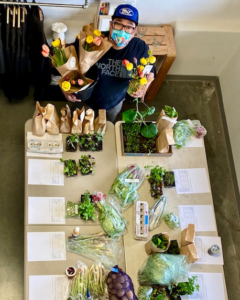Distribution Day, Pick-Up, Aggregation Location
Ensuring safe and efficient distribution requires preparation. Distribution days, pick-up points, and aggregation locations all require meticulous planning to guarantee the health and safety of both food and volunteers. The importance of prioritizing employee, volunteer, and customer well-being through proper hygiene practices and training cannot be emphasized enough, it is the most critical point of a well-run food hub. See food safety section of the manual for more information.
Preparing your distribution site:
- Temperature checks: Ensure all refrigeration units maintain temperatures below 41°F. Implement a temperature log for continuous monitoring.
- Food inspection policies: Thoroughly inspect incoming food for signs of spoilage or damage. Reject any items that don’t meet safety standards.
- Cottage food: Have your cottage food vendors follow the appropriate policies to ensure their food is safe. Consider reaching out to a cooperative extension agent to act as an educational aid to new cottage food vendors, ensuring they have access to the latest safe food handling practices.
- Specific food products: Some items (like oysters) require very stable temperatures and to maintain a certain upright position not to lose their liquor which also keeps them from spoiling.
- Location: Choose a well-organized, clean, and accessible space suitable for efficient distribution and food handling. Any frequently touched items such as tables or plastic bins should be regularly cleaned and disinfected.
- Hygiene: Provide handwashing stations, disposable gloves, and sanitizing wipes for volunteers and food handlers. Conduct hygiene training to ensure safe food practices are followed consistently.
- Training: Vendors should have appropriate training for their level of operation. Food safety handlers cards, or courses relevant to their type of food production can make a huge difference in producing safe high quality food.
By diligently preparing your distribution site and prioritizing safety, you can create a smooth and efficient experience for everyone involved, while guaranteeing the quality and integrity of the food reaching those in need.

Aggregation Day Guidelines
Employee/volunteer health and hygiene:
- Have employees or volunteers sign in upon arrival
- Wash hands and apply any required sanitary coverings.
- Review Health and Hygiene information if provided by Food Hub staff. A small poster to remind individuals not directly to touch food items or their phones can be helpful.
Receiving Farm Products
- Ensure the correct amount of each item is delivered with proper packaging and product labeling. Recommendations to include on product labeling include:
-
-
-
- Product Name
- Date of Harvest
- Farm Name
- “Keep Chill and Wash” if required.
-
-
- Check temperatures of any refrigeration units (below 41F). Recommend use of temperature log.
- Store farm products in appropriate locations until distribution. Ensure that any chilled or frozen products are properly stored.
Getting set up for Distribution
- Organize an open area with adequate table or counter space for packing customer orders.
- Print individual customer invoices for order packing.
- Pack customer orders (Mark products on invoices as they are added to orders to easily track progress)
Customer Order Pickup
- Send pickup reminder text or email to customers on the morning of distribution.
- Send out reminders to customers for unclaimed orders prior to distribution close. (At least 1 hour)
- Make a note on customer orders in food hub software if “unclaimed”. Orders are still contractual and can be charged but it’s good to keep a record if the order was unclaimed.
Process Payments
- Once distribution is complete and any refunds or price adjustments have been made, you can process payments for all customers and orders. This is best to complete after distribution in case of any payment adjustments.